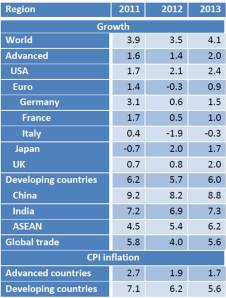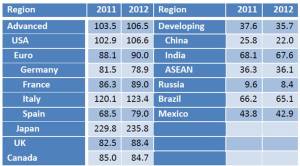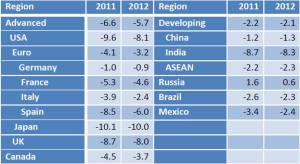Backdrop
The IMF believes that global prospects are gradually strengthening after the setback during 2011, though downside risks remain. This is mainly due to improved economic activity in USA during the second half of
2011 and pursuance of more effective policies in the euro area which have reduced the threat of a sharp global slowdown. Accordingly it is expected that there will be a weak recovery in the major advanced economies while there will be relatively more solid support from most emerging and developing economies.
Fundamentals
Global growth is projected to drop from 4% in 2011 to 3.5% in 2012 because of weak activity during the second half of 2011 and the first half of 2012. However, growth is expected to revert to the 2011 level in
2013 when hopefully the pending issues are ironed out successfully especially by the developed nations. Policy has played an important role in lowering systemic risk such as ECB’s three-year longer-term refinancing operations (LTROs), aggressive fiscal adjustment programs, and the launch of major product and labor market reforms. This has to an extent helped to stabilize conditions in the euro area thus relieving pressure on banks and sovereigns.
The euro area is still projected to go into a mild recession in 2012 as a result of the
o sovereign debt crisis and a general loss of confidence,
o effects of bank deleveraging on the real economy, and,
o pressure of fiscal consolidation in response to market pressures.
Overall growth is expected to turnaround in 2013, while 2012 will remain a year of cautious uncertainty given the risk factors involved. Advanced economies as a group would expand by about 1.5% in 2012 and by 2% in 2013. This would be an improvement over the 2011 level too. Italy however, is expected to still be in the negative territory with the recession getting protracted for another year. Japan on the other hand is to take lead in terms of growth in 2012 along with USA, but slowdown marginally in 2013.
Real GDP growth in the developing economies is projected to slowdown from 6.25% in 2011 to 5.75% in
2012 but recover to 6% in 2013, helped by easier macroeconomic policies and strengthening foreign demand. Both China and India are expected to slowdown in 2012 though the ASEAN group will continue to grow steadily in both 2012 and 2013.
Inflation however, is expected to come down in both 2012 and 2013 for both the advanced and developing nations, reflecting the tempering of commodity prices in the face of feeble economic growth in 2012.

The recovery process
Markets have been worried about fiscal sustainability in Italy and Spain all through 2011 which led to a sharp increase in sovereign yields. With the value of some of the banks’ assets in doubt there was apprehension on whether those banks would be able to convince investors to roll over their loans. This lead to freezing of credit which in turn resulted in erosion in confidence as activity slumped. Strong policy responses however turned things around. Elections in Spain and the appointment of a new Prime Minister in Italy gave some reassurance to investors. The adoption of a fiscal compact showed the commitment of EU members to dealing with their deficits and debt. Most important, the provision of liquidity by the ECB removed short-term bank rollover risk, which in turn decreased pressure on sovereign bonds. Some of the reforms seen were:
o The European Central Bank provided unlimited, collateralized three-year liquidity to banks which eased bank funding strains and contained the risk of illiquidity-driven bank failures.
o Governments in several countries, notably Italy and Spain, worked to reduce fiscal deficits.
o Ireland and Portugal made good progress in implementing their structural adjustment programs.
o Greece came to a major agreement to restructure debt held by the private sector, and a successor program has been agreed with the European Commission, the European Central Bank (ECB), and the IMF, and approved by both euro area member states and the IMF.
o Euro area banks are in the process of securing stronger capital positions under a European Banking
Authority (EBA)-coordinated initiative.
The concerns
There could however be two main brakes on growth: fiscal consolidation and bank deleveraging. While both are needed today, they will most certainly decrease growth in the short term. Fiscal consolidation is being implemented in most advanced economies while bank de-leveraging is affecting primarily Europe. While such de-leveraging does not necessarily imply lower credit to the private sector, the evidence suggests that it is contributing to a tighter credit supply.
How about emerging economies?
Emerging economies are not immune to these developments even though it does appear that they are decoupled in terms of pace of growth. Low advanced economy growth has meant lower export growth for them. Further financial uncertainty, together with sharp shifts in risk appetite, has led to volatile capital flows impacting their balance of payments and exchange rates. However, it has been observed that generally these countries had enough policy room to maintain stable growth. But, some countries need to watch overheating, while others still have a negative output gap and can use policy to sustain growth.
Major risks
Some of the risks that the global economy faces are quite different from the normal ones.
o Geopolitical tension affecting the oil market is the obvious and known risk. An increase in these prices by about 50 % would lower global output by 1.25%.
o Another acute crisis in Europe is an unknown one and given the developments that have taken place in
2011, can never be ruled out. Further escalation of the euro area crisis will cause output to decline by 2%
and 3.5% over a two-year horizon.
o Balancing the adverse short-term effects of fiscal consolidation and bank deleveraging versus their favorable long-term effects. Excessive tight macroeconomic policies could push the major economies into sustained deflation or a prolonged period of very weak activity.
· In the case of fiscal policy, the issue is complicated by the pressure from markets for immediate fiscal consolidation. Markets ask for fiscal consolidation but react badly when consolidation leads to lower growth.
· Deleveraging can lead to a credit crunch, either at home or abroad. Partial public recapitalization of banks does not appear to be on the agenda anymore, but perhaps should be.
o A latent risk could be the disruption in global bond and currency markets as a result of high budget deficits and debt in Japan and United States and rapidly slowing activity in some emerging economies.
Policy thrust
Measures should be taken to decrease the links between sovereigns and banks, creation of euro level deposit insurance, bank crisis resolution, and introduction of limited forms of Eurobonds including the creation of a common euro bill market. These measures are urgently needed and can make a difference were another crisis to take place soon. In the euro area, the recent decision to combine the European Stability Mechanism (ESM) and the European Financial Stability Facility (EFSF) is a good pragmatic move which will strengthen the European crisis mechanism and support the IMF’s efforts to bolster the global firewall.
In the United States and Japan, sufficient fiscal adjustment is planned over the near term but there is still an urgent need for strong, sustainable fiscal consolidation paths over the medium term. Also, given very low domestic inflation pressure, further monetary easing may be needed in Japan to ensure that it achieves its inflation objective over the medium term.
How about the developing countries?
Developing economies continue to reap the benefits of strong macroeconomic and structural policies, but domestic vulnerabilities have been gradually building. Growth has been supported by rapid credit growth and high commodity prices. To the extent that credit growth is a manifestation of financial deepening, this has been positive for growth. But in most economies, credit cannot continue to expand at its present pace without raising serious concerns about the quality of bank lending. Further, commodity prices are unlikely to grow at the elevated pace witnessed over the past decade, which means that fiscal and other policies have to adapt to lower potential output growth.
The challenges are to counter the impact of downside risks from advanced economies, ensuring that their economies do not overheat, control credit growth, tackle volatile capital flows, and have policies in place to counter inflation. Monetary policymakers need to be vigilant that oil price hikes do not translate into broader inflation pressure, and fiscal policy must contain damage to public sector balance sheets by targeting subsidies only to the most vulnerable households. This will hold in our own context too.
Fiscal indicators
The performance of governments across the world has become an important concern today in the light of the sovereign debt crisis that pervaded the euro region. The genesis lay in high unsustainable debt levels of the government that could not be serviced.
The table below gives the Government debt to GDP ratios for a set of countries in both the advanced and developing nations groups.

Debt levels remain at a higher level for the advanced countries relative to those of the developing nations. These levels are not expected to change significantly for the advanced nations while those for the developing nations would be tending to move downwards.

A similar picture is obtained also on the fiscal deficit side (ratio of government balances to GDP), where levels are higher for the advanced nations, which however, are expected to move downwards on account of fiscal consolidation (in Table -3 above). India’s fiscal balance is on the higher side within the set of developed nations covered here and is comparable with that of USA, Japan and UK.
—-Compiled and Presented [from Respective Sources for wider non-commercial circulation].
——————————————-Always Yours — As Usual —- Saurabh Singh










Impressions of Visitor & Few Replies